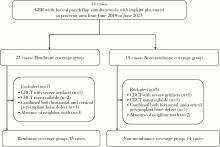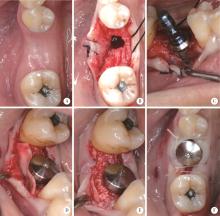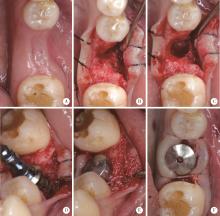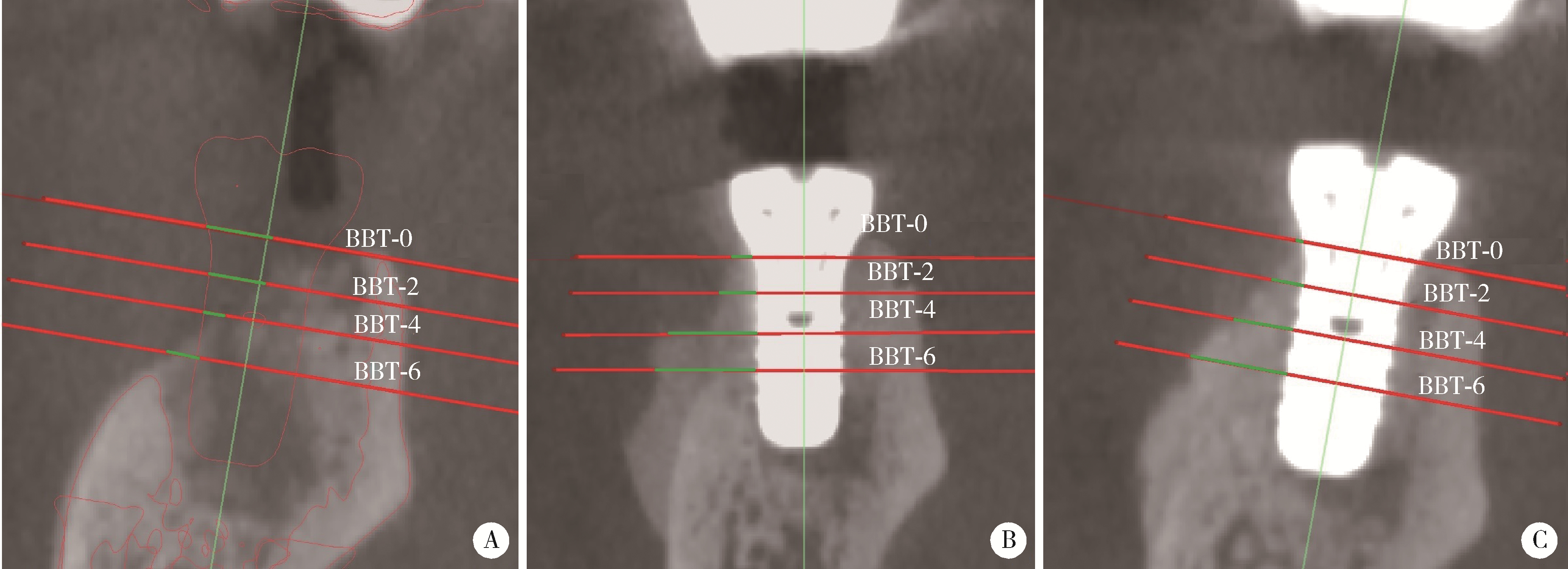Journal of Peking University (Health Sciences) ›› 2023, Vol. 55 ›› Issue (6): 1097-1104. doi: 10.19723/j.issn.1671-167X.2023.06.022
Previous Articles Next Articles
Role of collagen membrane in modified guided bone regeneration surgery using buccal punch flap approach: A retrospective and radiographical cohort study
Deng-hui DUAN1,Hom-Lay WANG2,En-bo WANG1,*( )
)
- 1. Department of Oral and Maxillofacial Surgery, Peking University School and Hospital of Stomatology & National Center for Stomatology & National Clinical Research Center for Oral Diseases & National Engineering Research Center of Oral Biomaterials and Digital Medical Devices & Beijing Key Laboratory of Digital Stomatology, Beijing 100081, China
2. Department of Periodontics and Oral Medicine, School of Dentistry, University of Michigan, Ann Arbor, MI, 48109, USA
CLC Number:
- R782.13
| 1 | Hammerle CH , Jung RE , Feloutzis A . A systematic review of the survival of implants in bone sites augmented with barrier membranes (guided bone regeneration) in partially edentulous patients[J]. J Clin Periodontol, 2002, 29 (Suppl 3): 226- 231. |
| 2 | Thoma DS , Bienz SP , Figuero E , et al. Efficacy of lateral bone augmentation performed simultaneously with dental implant placement: A systematic review and meta-analysis[J]. J Clin Perio-dontol, 2019, 46 (Suppl 21): 257- 276. |
| 3 |
Jung RE , Fenner N , Hämmerle CH , et al. Long-term outcome of implants placed with guided bone regeneration (GBR) using resorbable and non-resorbable membranes after 12-14 years[J]. Clin Oral Implants Res, 2013, 24 (10): 1065- 1073.
doi: 10.1111/j.1600-0501.2012.02522.x |
| 4 | Benic GI , Thoma DS , Jung RE , et al. Guided bone regeneration with particulate vs. block xenogenic bone substitutes: A pilot cone beam computed tomographic investigation[J]. Clin Oral Implants Res, 2017, 28 (11): e262- e270. |
| 5 |
Fu JH , Oh TJ , Benavides E , et al. A randomized clinical trial evaluating the efficacy of the sandwich bone augmentation technique in increasing buccal bone thickness during implant placement surgery: Ⅰ. Clinical and radiographic parameters[J]. Clin Oral Implants Res, 2014, 25 (4): 458- 467.
doi: 10.1111/clr.12171 |
| 6 | Ye GH , Duan DH , Wang EB . Ridge volume stability of maxillary anterior implants placed with simultaneous lateral guided bone regeneration during healing: A radiographic analysis[J]. Chin J Dent Res, 2021, 24 (4): 251- 256. |
| 7 |
Wang HL , Boyapati L . "PASS" principles for predictable bone regeneration[J]. Implant Dent, 2006, 15 (1): 8- 17.
doi: 10.1097/01.id.0000204762.39826.0f |
| 8 |
César Neto JB , Cavalcanti MC , Sapata VM , et al. The positive effect of tenting screws for primary horizontal guided bone regeneration: A retrospective study based on cone-beam computed tomography data[J]. Clin Oral Implants Res, 2020, 31 (9): 846- 855.
doi: 10.1111/clr.13630 |
| 9 |
Farias D , Caceres F , Sanz A , et al. Horizontal bone augmentation in the posterior atrophic mandible and dental implant stability using the tenting screw technique[J]. Int J Periodontics Restorative Dent, 2021, 41 (4): e147- e155.
doi: 10.11607/prd.5137 |
| 10 |
Duan DH , Wang HL , Xiao WC , et al. Bone regeneration using titanium plate stabilization for the treatment of peri-implant bone defects: A retrospective radiologic pilot study[J]. Clin Implant Dent Relat Res, 2022, 24 (6): 792- 800.
doi: 10.1111/cid.13139 |
| 11 |
Ciocca L , Lizio G , Baldissara P , et al. Prosthetically CAD-CAM-guided bone augmentation of atrophic jaws using customized tita-nium mesh: Preliminary results of an open prospective study[J]. J Oral Implantol, 2018, 44 (2): 131- 137.
doi: 10.1563/aaid-joi-D-17-00125 |
| 12 |
Her S , Kang T , Fien MJ . Titanium mesh as an alternative to a membrane for ridge augmentation[J]. J Oral Maxillofac Surg, 2012, 70 (4): 803- 810.
doi: 10.1016/j.joms.2011.11.017 |
| 13 |
Lee SR , Jang TS , Seo CS , et al. Hard tissue volume stability effect beyond the bony envelope of a three-dimensional preformed titanium mesh with two different collagen barrier membranes on peri-implant dehiscence defects in the anterior maxilla: A rando-mized clinical trial[J]. Materials (Basel), 2021, 14 (19): 5618.
doi: 10.3390/ma14195618 |
| 14 |
Sumida T , Otawa N , Kamata YU , et al. Custom-made titanium devices as membranes for bone augmentation in implant treatment: Clinical application and the comparison with conventional titanium mesh[J]. J Craniomaxillofac Surg, 2015, 43 (10): 2183- 2188.
doi: 10.1016/j.jcms.2015.10.020 |
| 15 |
Lin Z , Fateh A , Salem DM , et al. Periosteum: Biology and applications in craniofacial bone regeneration[J]. J Dent Res, 2014, 93 (2): 109- 116.
doi: 10.1177/0022034513506445 |
| 16 | Duan DH , Wang HL , Wang EB . Effect of intact periosteum on alveolar ridge contour stability after horizontal guided bone regene-ration in posterior region: A retrospective and radiographical cohort study[J]. Chin J Dent Res, 2023, 26 (4): 229- 236. |
| 17 |
Deng C , Yi Z , Xiong C , et al. Using the intact periosteum for horizontal bone augmentation of peri-implant defects: A retrospective cohort study[J]. Br J Oral Maxillofac Surg, 2022, 60 (10): 1325- 1331.
doi: 10.1016/j.bjoms.2022.09.012 |
| 18 |
Dahlin C , Linde A , Gottlow J , et al. Healing of bone defects by guided tissue regeneration[J]. Plast Reconstr Surg, 1988, 81 (5): 672- 676.
doi: 10.1097/00006534-198805000-00004 |
| 19 | Dahlin C , Sennerby L , Lekholm U , et al. Generation of new bone around titanium implants using a membrane technique: An experimental study in rabbits[J]. Int J Oral Maxillofac Implants, 1989, 4 (1): 19- 25. |
| 20 | Becker W , Becker BE , Handlesman M , et al. Bone formation at dehisced dental implant sites treated with implant augmentation material: A pilot study in dogs[J]. Int J Periodontics Restorative Dent, 1990, 10 (2): 92- 101. |
| 21 |
Louis PJ , Gutta R , Said-Al-Naief N , et al. Reconstruction of the maxilla and mandible with particulate bone graft and titanium mesh for implant placement[J]. J Oral Maxillofac Surg, 2008, 66 (2): 235- 245.
doi: 10.1016/j.joms.2007.08.022 |
| 22 |
Atef M , Tarek A , Shaheen M , et al. Horizontal ridge augmentation using native collagen membrane vs titanium mesh in atrophic maxillary ridges: Randomized clinical trial[J]. Clin Implant Dent Relat Res, 2020, 22 (2): 156- 166.
doi: 10.1111/cid.12892 |
| 23 |
Urban IA , Saleh MHA , Ravidà A , et al. Vertical bone augmentation utilizing a titanium-reinforced PTFE mesh: A multi-variate analysis of influencing factors[J]. Clin Oral Implants Res, 2021, 32 (7): 828- 839.
doi: 10.1111/clr.13755 |
| 24 |
Benic GI , Bienz SP , Song YW , et al. Randomized controlled clinical trial comparing guided bone regeneration of peri-implant defects with soft-type block versus particulate bone substitutes: Six-month results of hard-tissue changes[J]. J Clin Periodontol, 2022, 49 (5): 480- 495.
doi: 10.1111/jcpe.13606 |
| 25 |
Park SH , Lee KW , Oh TJ , et al. Effect of absorbable membranes on sandwich bone augmentation[J]. Clin Oral Implants Res, 2008, 19 (1): 32- 41.
doi: 10.1111/j.1600-0501.2007.01408.x |
| 26 |
Spray JR , Black CG , Morris HF , et al. The influence of bone thickness on facial marginal bone response: Stage 1 placement through stage 2 uncovering[J]. Ann Periodontol, 2000, 5 (1): 119- 128.
doi: 10.1902/annals.2000.5.1.119 |
| 27 |
Botticelli D , Berglundh T , Lindhe J . Hard-tissue alterations following immediate implant placement in extraction sites[J]. J Clin Periodontol, 2004, 31 (10): 820- 828.
doi: 10.1111/j.1600-051X.2004.00565.x |
| 28 |
Severi M , Simonelli A , Farina R , et al. Effect of lateral bone augmentation procedures in correcting peri-implant bone dehiscence and fenestration defects: A systematic review and network meta-analysis[J]. Clin Implant Dent Relat Res, 2022, 24 (2): 251- 264.
doi: 10.1111/cid.13078 |
| 29 |
Park JC , Kim CS , Choi SH , et al. Flap extension attained by vertical and periosteal-releasing incisions: A prospective cohort study[J]. Clin Oral Implants Res, 2012, 23 (8): 993- 998.
doi: 10.1111/j.1600-0501.2011.02244.x |
| 30 |
Monje A , Pons R , Vilarrasa J , et al. Significance of barrier membrane on the reconstructive therapy of peri-implantitis: A rando-mized controlled trial[J]. J Periodontol, 2023, 94 (3): 323- 335.
doi: 10.1002/JPER.22-0511 |
|
||







